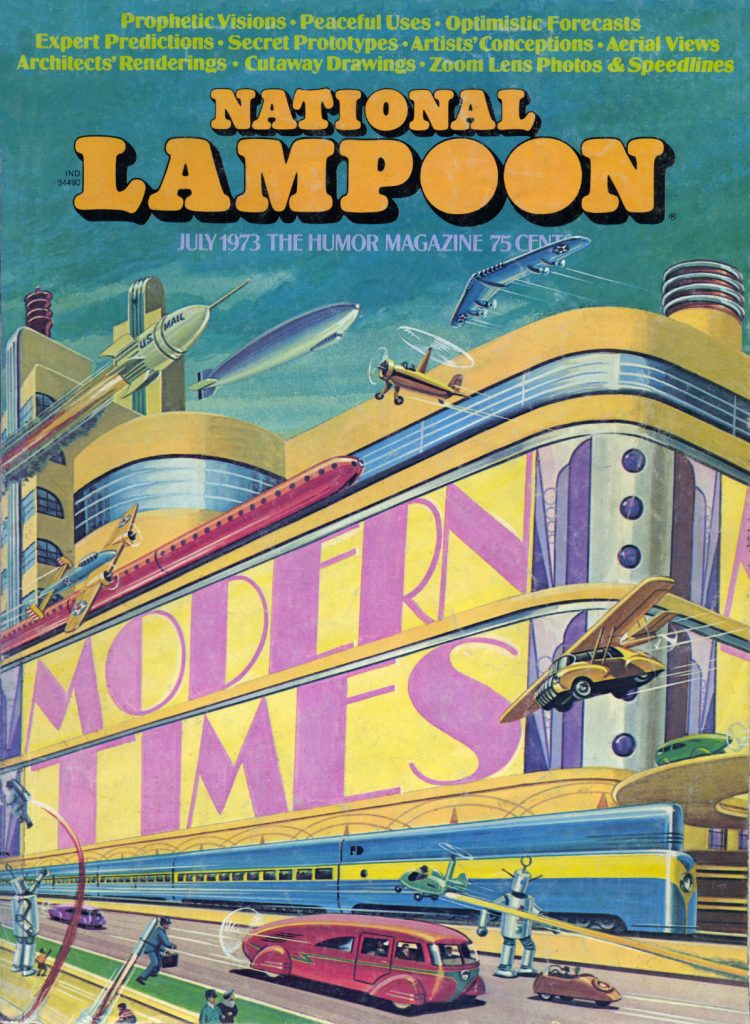Bruce McCall, R.I.P.
May 7, 2023

Bruce McCall, a frequent contributor to National Lampoon in the seventies and into the eighties, has died at age 87.
McCall both wrote and illustrated most of his articles and was especially known for what he called “retro futurism”, which he described as a vision of the future seen through the eyes of the past.
It was, in fact, McCall’s work that first drew me in to reading National Lampoon when I was in high school. First from seeing one of his “Bulgemobile” pieces in one of the anthologies on a magazine rack at K-mart, and then on the cover of the first copy of the magazine I bought, the August 1973 “Modern Times” issue, for which he was the guest editor.
I must have spent hours poring over his Popular Workbench piece in that issue, a parody of a typical issue of Popular Mechanics c. 1938. My grandfather had piles of those magazines in his basement and I used to crack up reading them when I was a kid. All McCall really did was to turn it up a notch.
His work made fun of the techno-optimism of the mid-twentieth century. Comparing his artwork with the illustrations from 1930s issues of Popular Mechanics or Popular Science, they’re only a little bit more ridiculous, but McCall had a knack for pushing things over the edge into hilarious absurdity. His ’58 Bulgemobiles weren’t just longer and wider than normal cars, they took up two lanes and made the adults driving them look like children. He came from the automotive advertising world and did the same thing with the copy with lines like, “So All-Fired New They Make Tomorrow Seem Like Yesterday!” and “FIREBLAST! Twice the car you’ll ever need—and that goes double for the new four-door FunTop!”
Much of McCall’s Lampoon work was reprinted in Zany Afternoons (1982). After NatLamp, he contributed articles to Esquire, Vanity Fair, and The New Yorker. Many of his post-NL pieces are collected in All Meat Looks Like South America (2003). He also produced several books of original material, including The Last Dream-O-Rama: The Cars Detroit Forgot to Build, 1950-1960 (2001), Marveltown, a book for kids (2008), and This Land Was Made for You and Me (But Mostly Me) with David Letterman (2013).
Finally, he wrote two memoirs, Thin Ice: Coming of Age in Canada (1997) and How Did I Get Here? (2020). I’ve only read the first one, and it was pretty good.
McCall also wrote for National Lampoon Radio Hour and did a brief stint as a writer for Saturday Night Live in the late seventies.
Looking back, McCall was one of my favorite contributors to National Lampoon. The magazine really wasn’t the same for me when he stopped writing for them.
There’s more about his life in his New York Times obituary.
Comments
Bruce was my favorite humorist/illustrator and I was fortunate enough to meet him on a couple of occasions. He spoke at the first ‘The New Yorker Festival’ about 20 years ago, describing the process of how cover art was selected and developed. His second memoir, “How did I get here” is more insightful than ‘Thin Ice’, well worth the read.
—Jim Martin
May 12, 2023 9:17 am
Original material (excluding quoted material) © 1997-2024 Mark Simonson.
Mark's Very Large National Lampoon Site is not affiliated with National Lampoon or National Lampoon Inc.
Click here for the real thing.

Leave a Reply